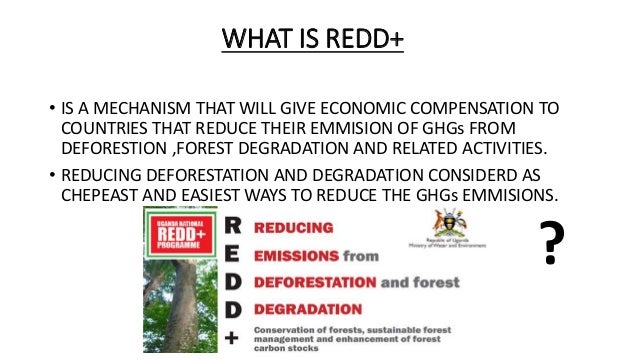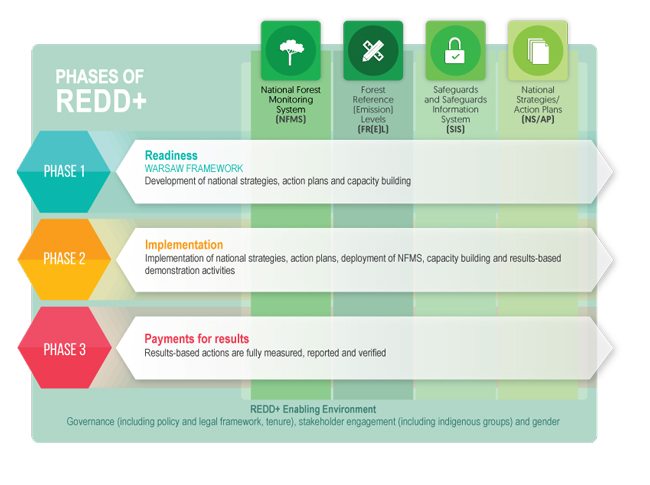Relevance: Prelims/Mains: G.S paper III: Environment

CONTEXT
Criticisms of REDD+ may leave the impression that this is an uncertain avenue for climate finance. The case for finance to flow to carbon sinks and forest communities, on the contrary, is stronger.
Reducing emissions from deforestation and forest degradation (REDD+) has emerged as a prominent carbon-sequestration mechanism since its adoption in 2007 at the United Nations Framework Convention on Climate Change (UNFCCC) Conference of Parties (COP) 13 in Bali.
ANALYSIS
REDD+ seeks to incentivise developing countries by creating financial value for stored carbon in forests. It offers a potentially fast and cheap means to achieve the Paris Agreement goal of keeping global warming below 1.5 degrees Celsius over pre-industrialised era.

It does so by means of a results-based payment mechanism targeted at five activities:
- Reducing emissions from deforestation
- Reducing emissions from forest degradation
- Conservation of carbon stocks
- Sustainable management of forests
- Enhancement of carbon stocks
Brazil became one of the first countries to receive results-based aid last year. This year, Uganda became eligible for REDD+ payments, the first African country to do so.
The Cancun Agreements adopted at COP 16 set out seven safeguards to mitigate negative impacts of REDD+ activities. This includes the requirement for respect for the knowledge and rights of indigenous peoples and members of local communities and the full and effective participation of relevant stakeholders.

Additionally, in order to receive results-based finances from REDD+ implementation, the Warsaw Framework requires a recipient country to develop a system for providing information on how safeguards are addressed and respected.
Additional safeguard requirements may be required to be followed by developing countries. This can be based on contractual requirements of multilateral funds for project-based REDD+ activities.
The Green Climate Fund (GCF), for instance, allocated $500 million for its pilot programme for REDD+ results-based payments and also adopted an ‘Indigenous Peoples Policy’ which is applicable to GCF-financed activities in REDD+ actions.
As countries interpret and formulate safeguards in their own way, a heterogeneous implementation of REDD+ safeguards may lead to potential negative impacts on forest dependent communities.

Some of the risks associated with REDD+ include:
- Violation of rights of potentially affected communities and increased socio-economic and environmental vulnerabilities
- Adoption of a top-down approach that can disrupt traditional forest management and use, traditional livelihoods and potentially exacerbate conflicts
- Shortcomings in enforcement and implementation of protocols and safeguards that can prevent benefits from reaching indigenous peoples
Major roadblocks for homogenous application of safeguards are social, economic and political factors in each country and the historical relationship between nations and indigenous peoples, including the varied interpretation of rights under the UN Declaration on the Rights of Indigenous Peoples and the International Labour Organization’s Convention 169.
Case studies focused on participation in REDD+ project activities are testament to the limited stakeholder consultation in affected communities.
In Guyana and Indonesia, findings support limited information sharing and in Tanzania, case reports found prevalence of uneven awareness, with women and poorer villagers being less informed about project activities.
Studies also reported instances of allegations of violation of rights of indigenous peoples during REDD+ readiness and implementation activities, especially in countries with varied histories of indigenous rights and pre-existing land conflicts, including Ecuador, Indonesia, Kenya, Peru and Tanzania.
On the other hand, case studies from Kenya and Nepal show an increase in women’s participation in village decision-making processes pursuant to REDD+ initiatives.
There has been learning from the above case studies, leading to a stronger sense of the approaches required to sustainably reap the non-carbon benefits of forests. These may be broadly categorised into the following:
Rights-based approach: In the absence of tangible co-benefits for indigenous communities from REDD+ initiatives, countries should at the very least adopt a ‘do no harm’ approach. This may be achieved by increasing access to justice and building a credible grievance mechanism throughout the readiness and implementation process, actively engaging indigenous peoples in the decision-making process and focusing on capacity building efforts at the grassroots level.
Bottom-up approach: This involves restructuring of the forest management system by adopting a decentralised approach in developing countries, which entails a greater share of rights, responsibilities and decision-making power with the local communities. In the Indian context, for instance, decentralisation of forest rights and community-based forest governance was identified as critical to the success of REDD+ initiatives for forest-dwelling and forest-dependent communities.
Capacity building for meaningful participation:
REDD+ initiatives should emphasise cultivating trust throughout the process for meaningful engagement, improving outreach and providing opportunities for inclusive decision-making to be truly beneficial to local communities and indigenous people. The importance and relevance of a right-based approach with a strong emphasis on free, prior and informed consent cannot be ignored.
Despite the stumbles, the potential for REDD+ to help forest rich countries meet their climate ambition should not be dismissed.
India’s Nationally Determined Contribution — in compliance with Paris Agreement targets — submitted an additional carbon sink of three billion tonnes of CO2 equivalent through additional forest and tree cover by 2030.
A well-defined REDD+ programme in India can help in capturing as much as one billion tonnes of additional CO2 over 30 years, according to an estimate from the Union Ministry of Environment, Forests and Climate Change.
Such estimates are still subject to significant uncertainty. Methods for measuring forest carbon and establishing the creation of truly ‘additional’ carbon sinks are not standardized yet.
At first glance, this may look like a purely technical or scientific problem, requiring the institution of appropriate monitoring, reporting and verification (MRV) protocols. There is, however, emerging evidence that the above community-centered recommendations may also offer a strong guide through the additionality problem.
Under the right conditions, communities would be willing to engage in participatory forest resource mapping because it enhances their understanding of their own resources, threats and potentials. This process is broader than carbon measurement, but it can generate reliable data related to carbon stocks at a lower cost than top-down MRV.
The challenge is for decision-makers to trust the quality of data generated by communities. That will require a shift in mentality, but also more investment in institutions and capacity building.
Criticisms of REDD+ may leave the impression that this is an uncertain avenue for climate finance. The case for finance to flow to carbon sinks and forest communities, on the contrary, is stronger than ever.
It is the definition of ‘result’ that needs to evolve to one that bears equity and human concerns at the heart of the climate crisis in mind.
For more such notes, Articles, News & Views Join our Telegram Channel.
Click the link below to see the details about the UPSC –Civils courses offered by Triumph IAS. https://triumphias.com/pages-all-courses.php

